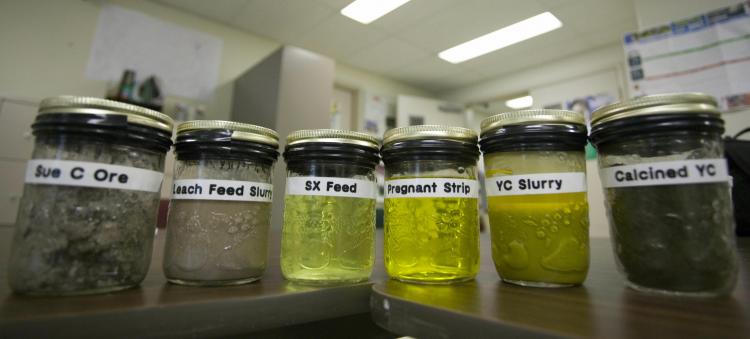Thanks to revived interest in nuclear energy as an alternative energy source, the prices of uranium are booming, adding more value to Canada’s ever-thriving natural resources sector.
The rise in demand has prompted increased exploration activities in Canada and some provinces have been re-thinking the issue of uranium mining after many years.
Currently, Saskatchewan is the only province that has uranium mining, and as the word’s largest uranium production region it accounts for 30 per cent of the annual world production.
Earlier in July, New Brunswick imposed strict regulations on uranium exploration to protect watersheds and land owners. This came after an outcry about the possibility of uranium mining and private landowner’s concern over mineral rights claims to their land.
However, the province stopped short of imposing a ban on uranium mining as requested by some environmental groups.
British Columbia imposed a moratorium on mining exploration while Labrador’s Nunatsiavut government introduced a three-year moratorium on uranium mining (but not exploration) in April this year.
In Nova Scotia, the Conservative government is seeking input from the public on the issue before revisiting the province’s moratorium on exploration imposed many years ago.
Jennifer Gavin, a spokeswoman for Nova Scotia Natural Resources Department, says the minister would only look at the moratorium if uranium mining is proven scientifically safe, benefits the province’s economy, and has the support of the majority of Nova Scotians.
“The first two, we have a lot of evidence to say that Uranium mining can be done safely,” Gavin says, citing the McCleave inquiry of the 1980s and the 1994 Interdepartmental Uranium Committee.
That report concluded that there is no “scientific evidence” to show that exploration for uranium, if done according to the relevant regulations, would “adversely” affect the environment or the health of the people performing the work and recommended the moratorium on exploration and mining be lifted.
“If we look at other provinces and other countries, it is proven that there is a large economic benefit to uranium mining and exploration,” says Gavin, adding however that it’s still uncertain whether the majority of Nova Scotians support it.
“We’re getting a feel for what Nova Scotians think about uranium and uranium mining and what their values are and this will be weighed heavily to see if the minister would take a look at this again,” she says.
The moratorium is being challenged by the Nova Scotia Mining Association.
“Our province moves forward with looking at alternative energy sources so nuclear sources are an option,” says Michelle Landreville, executive director of Mining Association.
“Our policy is that we support uranium exploration.”
The United States is experiencing a resurgence in uranium mining after 30 years due to the development of nuclear power plants in countries like India and China.
In a presentation before the provincial standing committee on resources last April, Mining Association past president Gordon Dickie said that the technology available today can ensure uranium mining can be done in a safe manner without causing harm to the environment or the workers.
“Canada is the world’s largest producer of uranium and virtually all of it today is from northern Saskatchewan. The technology is available and the method is available to treat high-grade tailings to manage sites,” he said.
Dickie also argued that the current moratorium limits other mining activity since under its terms, exploration needs to stop if uranium at more than 100 parts per million is found.
“In exploring for other metals it’s clearly a negative if there is a risk of finding over100 ppm uranium in Nova Scotia,” he said.
The moratorium was put in place in 1982 after public concerns about uranium mining, but its legal status is somewhat unclear.
NDP environment critic Graham Steele has introduced a bill that seeks to legislate the ban, saying the issues imposed by the moratorium limiting other exploration and mining activities need to be addressed.
Environmental groups in Nova Scotia have also requested a permanent legal moratorium to be put in place and have prompted some municipalities to pass motions requesting a ban.
“The environmental consequences with uranium mining are quite serious,” says Donna Smith, a spokesperson for the Citizens Action to Protect the Environment (CAPE).
“We’re a small province and where the current uranium claims are filed, most of the area is natural watershed area…and so things are very worrisome in terms of potential contamination through [seepage] or spills or floods...into the ground water, aquifers and then flooding into surface water,” she says.
Smith says the land on which the mine is developed will become contaminated with radioactive and heavy materials. In addition, the wastes and byproducts have to be stored in tailings ponds which need to be impervious to natural events for thousands of years until the products decay into a safe stable form.
“It’s an enormous undertaking,” she says.
Additional reporting by Diana Hubert.
The rise in demand has prompted increased exploration activities in Canada and some provinces have been re-thinking the issue of uranium mining after many years.
Currently, Saskatchewan is the only province that has uranium mining, and as the word’s largest uranium production region it accounts for 30 per cent of the annual world production.
Earlier in July, New Brunswick imposed strict regulations on uranium exploration to protect watersheds and land owners. This came after an outcry about the possibility of uranium mining and private landowner’s concern over mineral rights claims to their land.
However, the province stopped short of imposing a ban on uranium mining as requested by some environmental groups.
British Columbia imposed a moratorium on mining exploration while Labrador’s Nunatsiavut government introduced a three-year moratorium on uranium mining (but not exploration) in April this year.
In Nova Scotia, the Conservative government is seeking input from the public on the issue before revisiting the province’s moratorium on exploration imposed many years ago.
Jennifer Gavin, a spokeswoman for Nova Scotia Natural Resources Department, says the minister would only look at the moratorium if uranium mining is proven scientifically safe, benefits the province’s economy, and has the support of the majority of Nova Scotians.
“The first two, we have a lot of evidence to say that Uranium mining can be done safely,” Gavin says, citing the McCleave inquiry of the 1980s and the 1994 Interdepartmental Uranium Committee.
That report concluded that there is no “scientific evidence” to show that exploration for uranium, if done according to the relevant regulations, would “adversely” affect the environment or the health of the people performing the work and recommended the moratorium on exploration and mining be lifted.
“If we look at other provinces and other countries, it is proven that there is a large economic benefit to uranium mining and exploration,” says Gavin, adding however that it’s still uncertain whether the majority of Nova Scotians support it.
“We’re getting a feel for what Nova Scotians think about uranium and uranium mining and what their values are and this will be weighed heavily to see if the minister would take a look at this again,” she says.
The moratorium is being challenged by the Nova Scotia Mining Association.
“Our province moves forward with looking at alternative energy sources so nuclear sources are an option,” says Michelle Landreville, executive director of Mining Association.
“Our policy is that we support uranium exploration.”
The United States is experiencing a resurgence in uranium mining after 30 years due to the development of nuclear power plants in countries like India and China.
In a presentation before the provincial standing committee on resources last April, Mining Association past president Gordon Dickie said that the technology available today can ensure uranium mining can be done in a safe manner without causing harm to the environment or the workers.
“Canada is the world’s largest producer of uranium and virtually all of it today is from northern Saskatchewan. The technology is available and the method is available to treat high-grade tailings to manage sites,” he said.
Dickie also argued that the current moratorium limits other mining activity since under its terms, exploration needs to stop if uranium at more than 100 parts per million is found.
“In exploring for other metals it’s clearly a negative if there is a risk of finding over100 ppm uranium in Nova Scotia,” he said.
The moratorium was put in place in 1982 after public concerns about uranium mining, but its legal status is somewhat unclear.
NDP environment critic Graham Steele has introduced a bill that seeks to legislate the ban, saying the issues imposed by the moratorium limiting other exploration and mining activities need to be addressed.
Environmental groups in Nova Scotia have also requested a permanent legal moratorium to be put in place and have prompted some municipalities to pass motions requesting a ban.
“The environmental consequences with uranium mining are quite serious,” says Donna Smith, a spokesperson for the Citizens Action to Protect the Environment (CAPE).
“We’re a small province and where the current uranium claims are filed, most of the area is natural watershed area…and so things are very worrisome in terms of potential contamination through [seepage] or spills or floods...into the ground water, aquifers and then flooding into surface water,” she says.
Smith says the land on which the mine is developed will become contaminated with radioactive and heavy materials. In addition, the wastes and byproducts have to be stored in tailings ponds which need to be impervious to natural events for thousands of years until the products decay into a safe stable form.
“It’s an enormous undertaking,” she says.
Additional reporting by Diana Hubert.







